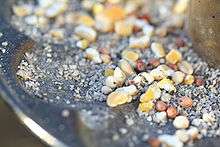Bird food
Bird food is food (often varieties of seeds, nuts, or dried fruits) eaten by birds. While most bird food is fed to commercial fowl, people also use bird food to feed their pet birds or wild birds.

The various types of bird food reflect the species of bird that can be fed, whether they are carnivores or nectar eating birds.
While it is a popular practice to feed wild birds from bird feeders, they can carry potential risks for the birds that feed there, such as disease,[1] malnutrition,[2] and predation by domestic animals.[3] Researchers recommend that bird feeders be disinfected every time they are refilled.[1]
Types
Natural
Seed
Black sunflower seeds are highly recommended for use in bird feeders because they attract a wide variety of birds, have a high ratio of meat to shell, and are high in fat content.[4][5] Other common bird seeds include Niger, or thistle seed, a favorite of goldfinches, millet for sparrows and juncos, and safflower for cardinals, among others.[4][5]
Non-seed
Suet is recommended for insect-eating birds like nuthatches and woodpeckers.[4] Artificial nectar – essentially sugar water – attracts hummingbirds.[4] Bread and kitchen scraps are often fed to ducks and gulls (although this can lead to nutrient deficiencies and increased defecation for the birds in question). Chickens are commonly fed maize, wheat, barley, sorghum and milling by-products, in a mixture traditionally called chicken scratch. Pet parrots are fed fresh fruit, vegetables and nuts (in addition to seed).
These seeds and non-seed supplies are commonly obtained as by-products on farms, but can also be bought from independent retailers.
Commercial
Nonfarm
Commercial bird food is widely available for feeding wild and domesticated birds, both seed combinations and pellets.[5][6]
When feeding wild birds the Royal Society for the Protection of Birds (RSPB)[7] suggests that it be done year round, with different mixes of nutrients being offered each season. Selections should have additional fat content in the winter months, and additional proteins in the form of nuts, seeds and dried worms in summer when birds are changing their plumage and may be molting.
Farm
Farmed birds fed commercial bird food typically are given very specific scientifically designed pre-blended feed. Examples of commercial bird food for chickens include chick starter medicated crumbles, chick grower crumbles, egg layer mash, egg layer pellet, egg layer crumbles, egg producer pellet, and broiler maker med crumbles.[8] Pellet crumbles are often prepared for tiny chicks. Mash is more finely ground.
References
- "Birds that eat at feeders more likely to get sick, spread disease". Retrieved 2017-01-31.
- "Feeding birds". The RSPB. Retrieved 2017-01-31.
- "Backyard Feeders: Dangers To Watch Out For | Petcha". www.petcha.com. Retrieved 2017-01-31.
- What to Feed Birds and Seeds and Grains for Birds. Project FeederWatch. Retrieved on August 23, 2006
- Porter, Diane. Winter Bird Feeder: Keep Them Coming Back. Retrieved on August 23, 2006.
- Choosing Bird Food. All About Birds. Cornell Lab of Ornithology. Retrieved on August 23, 2006.
- "When to feed wild birds". The RSPB. Retrieved 2016-03-02.
- Jacob, Dr. Jacquie. "Feeding Chickens for Egg Production". Extension.org. Extension. Retrieved 2019-01-15.